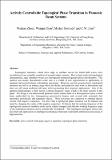| dc.contributor.author | Zhou, Weijian | |
| dc.contributor.author | Chen, Weiqiu | |
| dc.contributor.author | Destrade, Michel | |
| dc.contributor.author | Lim, C.W. | |
| dc.date.accessioned | 2020-12-07T09:20:19Z | |
| dc.date.issued | 2020-05-01 | |
| dc.identifier.citation | Zhou, Weijian, Chen, Weiqiu, Destrade, Michel, & Lim, C. W. (2020). Actively controllable topological phase transition in phononic beam systems. International Journal of Mechanical Sciences, 180, doi:https://doi.org/10.1016/j.ijmecsci.2020.105668 | en_IE |
| dc.identifier.issn | 0020-7403 | |
| dc.identifier.uri | http://hdl.handle.net/10379/16364 | |
| dc.description.abstract | Topological insulators, which allow edge or interface waves but forbid bulk waves, have revolutionized our scientific cognition of acoustic/elastic systems. Due to their nontrivial topological characteristics, edge (interface) waves are topologically protected against defects and disorders. This superior and unique characteristic could lead to a wealth of new opportunities in applications of quantum and acoustic/elastic information processing. However, current acoustic/elastic topological insulators are still at an infancy stage where the theory and prediction only work in laboratories and there are still many problems left open before promoting their practical applications. One of the apparent disadvantages is their narrow working frequency range, which is the main concern in this paper. We design a one-dimensional phononic beam system made of a homogeneous epoxy central beam sandwiched by two homogeneous piezoelectric beams, and covered with extremely thin electrodes, periodically and separately placed. These electrodes are connected to external electric circuits with negative capacitors. We show that a topological phase transition can be induced and tuned by changing the values of the negative capacitors. It follows that the working frequency of the topologically protected interface mode can be widely changed, such that the working frequency range of the topological insulator can be considerably 'broadened'. This intelligent topological device may also find wide applications in intelligent technologies that need controllable information processing of high precision. | en_IE |
| dc.description.sponsorship | The work described in this paper was supported by PROCORE-France/Hong Kong Joint
Research Scheme (Project No. FCityU108/17) and National Natural Science Foundation of China
(Nos. 11532001 and 11621062). | en_IE |
| dc.format | application/pdf | en_IE |
| dc.language.iso | en | en_IE |
| dc.publisher | Elsevier | en_IE |
| dc.relation.ispartof | International Journal Of Mechanical Sciences | en |
| dc.rights | Attribution-NonCommercial-NoDerivs 3.0 Ireland | |
| dc.rights.uri | https://creativecommons.org/licenses/by-nc-nd/3.0/ie/ | |
| dc.subject | Active control | en_IE |
| dc.subject | Band gaps | en_IE |
| dc.subject | Negative capacitor | en_IE |
| dc.subject | Topological phase transition | en_IE |
| dc.subject | WAVES | en_IE |
| dc.subject | PROPAGATION | en_IE |
| dc.subject | BEHAVIOR | en_IE |
| dc.title | Actively controllable topological phase transition in phononic beam systems | en_IE |
| dc.type | Article | en_IE |
| dc.date.updated | 2020-12-05T19:03:55Z | |
| dc.identifier.doi | 10.1016/j.ijmecsci.2020.105668 | |
| dc.local.publishedsource | https://doi.org/10.1016/j.ijmecsci.2020.105668 | en_IE |
| dc.description.peer-reviewed | peer-reviewed | |
| dc.contributor.funder | National Natural Science Foundation of China | en_IE |
| dc.contributor.funder | France/Hong Kong Joint Research Scheme | en_IE |
| dc.description.embargo | 2022-05-01 | |
| dc.internal.rssid | 21718058 | |
| dc.local.contact | Michel Destrade, Room Adb-1002, Áras De Brun, School Of Mathematics, Nui Galway. 2344 Email: michel.destrade@nuigalway.ie | |
| dc.local.copyrightchecked | Yes | |
| dc.local.version | ACCEPTED | |
| nui.item.downloads | 34 | |


